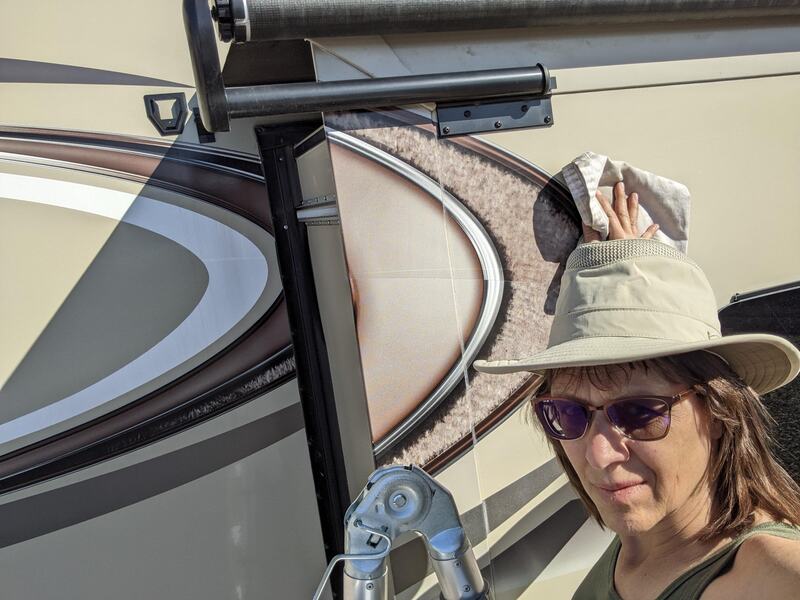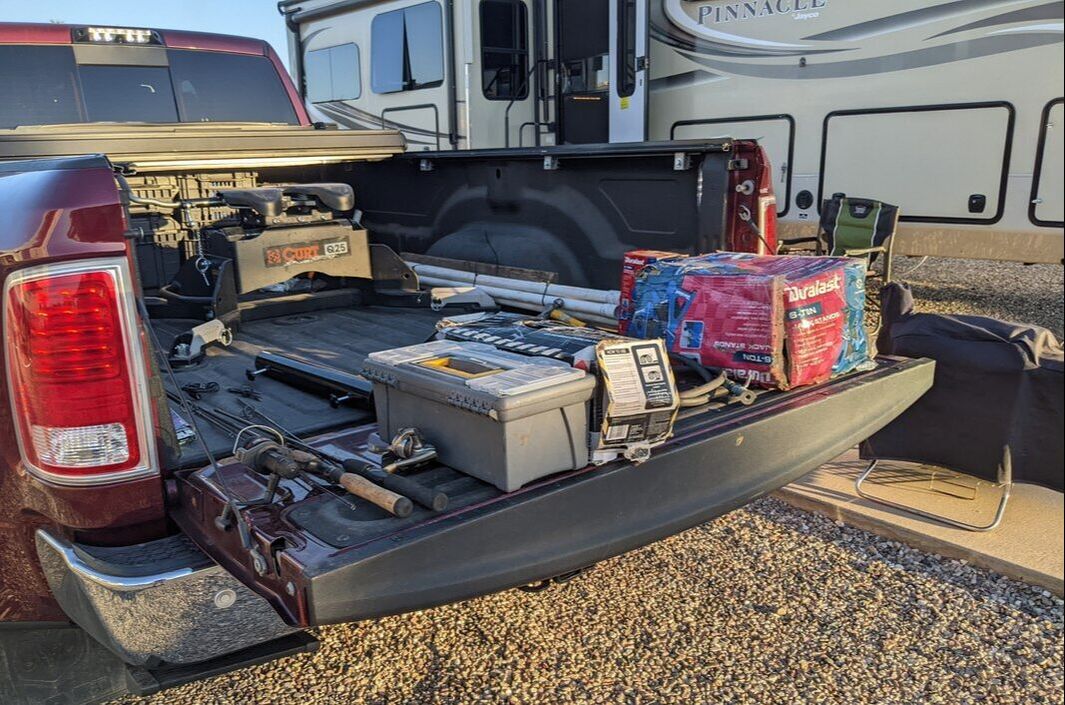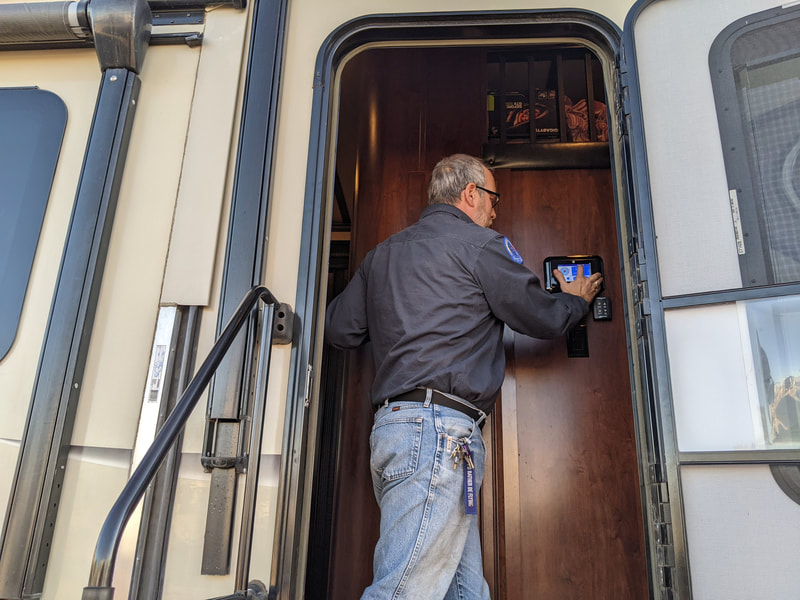|
An incessant beeping shocked us out of our slowly waking slumber. Normally, that sound would indicate we had run out of propane. Since we had just topped our propane tanks a couple of days earlier and not used much, we knew that couldn’t be the case.
I crawled out of bed, threw on my robe, and stumbled to the bathroom to find a flashing light and the source of the unwelcome noise. Our energy monitor indicated we had depleted all of our battery power. When we had arrived at our first travel stop, an overnight stay with no hookups, Bob plugged the coach into itself. It’s a means he rigged to run our power outlets and appliances off our batteries when we’re off the grid. We flip our power converter switch off so the batteries don’t try to charge themselves, which wouldn’t work anyway. We had used that electricity to run some lights, microwave our dinner, and watch TV before bed. It shouldn’t have been enough to drain our 510 amp-hour batteries. Power Source Before we had set out on our travels, I had switched the refrigerator control to the electric/propane option, thinking it would run off propane until we plugged into shore power. Because the trailer was plugged into itself, Tagalong thought he was connected to a traditional source of electricity. As a result, the power-hungry refrigerator ran on electric rather than propane energy and drained our batteries. That meant we didn’t have enough juice to run our water pump. And that meant we couldn’t flush our toilet. We donned warm clothes and braved the freezing temperature (it was literally 32 degrees) to walk across the expansive dirt lot to the building at our rest stop — only to find the doors chained closed. Crossing our legs and eating a cold breakfast would have to do. Fortunately, the sun had just started to peek over the horizon, offering hope of charging our batteries through the solar panels on our roof. Rookie Mistakes The battery draining incident was only one of many mistakes we made in our first day back on the road after five months stationary. We’re definitely creatures of habit. After getting out of the habit of moving every week, we forgot a lot of the necessary steps. For example, we had to relearn that we need to make wide turns and allow for extra braking time when towing our 42-foot fifth-wheel trailer. We also had to refresh our memories about the importance of scouting our stops ahead of time using Google Maps to ensure we could safely get in and out — and reading a map correctly for proper navigation. I led us the wrong way into a fuel stop, which is a big deal when semi-trucks are coming at you. Listening to Mike Rowe’s soothing voice in his “The Way I Heard It” podcast reminded us not to be in a hurry and not to worry about the people behind us. Communication always plays a role in traveling together, and we had to relearn some pointers for success in that area as well — namely, speaking up. We had a much better second day of travel and arrived at our destination safely. We’re sure to encounter more lessons on our journey. For now, we’re happy to have new scenery and a fresh outlook for the adventures that lay ahead. See how far we've come in two years: 5 Lessons Learned on the First Leg of Our RV Journey.
0 Comments
Gulliver, our Dodge Ram 3500 dually, is worth the same amount we paid for him more than four years ago. But he’s much more valuable to us than he would be to a thief. So, we decided to invest in protecting that value. If Gulliver were to be stolen, we likely wouldn’t get a dually truck as a rental replacement. And that would mean we couldn’t move our trailer. With the supply chain delays, it could be months to a year or even longer before we could get a replacement truck. Not willing to take that risk, we upgraded Gulliver with a new security gadget. After tons of internet research, Bob ordered a Ravelco anti-theft device. A technician came right to our camping spot to install the unit. In about an hour, he replaced the ignition wires under the hood so that they’re all black and nestled in an armored tube. They end in a female receiver that requires a male fob to connect to it before the engine will turn over with the key. This means our truck can’t be hot-wired. As an added layer of protection, the tech gave us window stickers that say “No Hot Wire” in hopes that wannabe thieves will see Gulliver is not an easy target and move on. Liver Transplant Gulliver also got two new fuel filters. Like a human liver that rids the body of toxic substances, a fuel filter rids a vehicle’s fuel of harmful debris — rust particles and dirt — to prevent damage to the engine. Thanks to those transplants, Gulliver’s ready to process the 250 or so 32-gallon tanks of diesel we’ll likely power through on this year’s travel adventures. Bug Protection Not to be left out, Tagalong got upgraded screening on his screen door. The original screening had steadily deteriorated in the 2.5 years we’ve owned him — to the point that pesky bugs were likely to break through this year. Since we plan to spend time in some humid areas of the country, we didn’t want to risk pests infecting our living quarters. Bob removed the screen door and took it to Ace Hardware. One day and $60 later, it had been rescreened with thicker, darker material that will not only keep the bugs out, but also protect our entry from sun and heat. Wax Job You can just imagine what a beating an RV takes in a year of traveling through different weather. Sometimes it bakes in the sun. Other times, it’s plastered with rain. And then there’s the wind that beats against it. Wanting to protect Tagalong’s neglected exterior, I spent two days washing and waxing him. That’s one luxury of a long-term RV stay: full hookups and the ability to take care of vehicle maintenance. The rubber roof sucked up the wax, thirsty for a fresh coat. The sun-facing side of the trailer did the same. The shady side, not quite so thirsty, welcomed the added protection. All in all, the job took about 10 hours. Next time, we’ll pay someone to do it. But for now, we rest easy knowing our home is well-preserved.
The first time we drove through the RV part of the mobile home park we’ve been staying at was to see the wares for purchase as part of a parkwide yard sale. I remember being surprised that RVers had things to sell. With precious limited space, it made sense to me that they’d only carry what they had room for. Fast-forward a few years, and I have a new understanding and appreciation for those RVers showcasing their undesirables for sale. After two years on the road, we managed to accumulate quite a bit ourselves — especially while stationary. Purging Our Possessions Wanting to lighten our load before hitting the road again, we took a full day to address our accumulation issue. We went through every cabinet in Tagalong — inside and out — to determine what to keep and what to purge. Starting in the bedroom, we sorted through all of our clothes, hanging and folded, and formed three piles of giveaways. Eager to keep the momentum going, we moved to the bathroom and consolidated what we could and trashed what we didn’t need. From there, we transitioned to the kitchen, going through all seven drawers and 14 cabinets, including the pantry, to wipe them down and identify items we could do without. Next came the living room, mostly electronics. We found lots of objects we hadn’t used in two years and didn’t need. I almost forgot about my office with its door closed. That’s what I love about it: I’m able to close the door at the end of the workday and be home, forgetting that the little room exists behind its entry. After going through the six drawers in there, I eradicated a mountain of printed documents. Cleaning the Cellar Three bags and two boxes of donation items later — plus two trash bags of throwaways — we moved outside. Recovering from his second cataract surgery, Bob sat while I pulled containers from Tagalong’s bowels. We pilfered through bin after bin, finding things we could have used if we knew we had them, such as a bee sting kit. That could have come in handy when Bob stepped on a bee at Lake Michigan and it stung the underside of his foot. We found plenty of possessions to part with: fishing poles and a tackle box, jack stands, a bottle jack since we had a newer one, a gas hose, drawer racks, and other odds and ends. We loaded RV living items onto Gulliver’s tailgate and drove around the park, stopping where we saw other RVers sitting outside, enjoying Arizona’s beautiful February weather. Our tactic worked, and people took our non-essentials. The rest of the RV living goods we stashed next to the dumpster. A half hour later when I returned to deposit our three bags of trash (yes, we filled another one), most of the items had already disappeared, no doubt going to homes where they’d be put to good use.
As with a sticks-and-bricks home, our fifth wheel requires annual maintenance. Since I had a day off work, we decided to address some items. Seeing Is Believing Midway through our travels in 2021, Tagalong’s backup camera stopped working. It comes in handy not only for backing into camping spots, but also for changing lanes on the freeway, letting us know if we have enough clearance from another vehicle given our length. Our RV driving school instructor would be proud we learned how to change lanes successfully without relying on the camera, instead using our rearview mirrors and shadows. We learned how to park the rig without the camera too. But we thought it would be nice to have that extra visibility back. We tried a new cord, but that didn’t solve the missing picture issue. So, we ordered a new camera monitor. We had to pair the new monitor with Tagalong’s side cameras first. After a few tries, the monitor recognized those cameras, so we moved on to the rear camera. But it wouldn’t connect no matter what we did. RV forums informed us we needed to check the wiring behind the camera — no easy task considering the camera is 13 feet off the ground and our onboard RV ladder is a couple of feet to the left of the camera. Fortunately, we travel with a 16.5-foot telescoping ladder.* Bob climbed that, and I hung off the onboard ladder. He removed four small screws, and the camera came right out. Only then did we see that the wire connection for the rear camera had jimmied loose during travel. Bob pushed the connection back together and replaced the screws to hold the camera in place. The monitor recognized it, and the camera appears to be back in working condition. Pump It Up We hit the one-year mark for greasing Tagalong’s wheel bearings So, we closed our slideouts and connected the trailer to Gulliver, believing that to be the safest approach. I crawled under the trailer to put our new 6-ton bottle jack* to use (after our failed jacking experience in Michigan). Recovering from cataract eye surgery, Bob had doctor's orders to avoid heavy lifting. I got Tagalong’s starboard side rear axle high enough for the rearmost tire to spin, a necessity for a grease job. Bob connected his grease gun to the wheel, and we tag-teamed rotating the tire and squeezing in grease. With that tire done, we lowered the trailer and repeated the process three more times for the other wheels. Pleased and exhausted after a job well done, we disconnected Gulliver from Tagalong to put our house back together. Remembering our leveling troubles from October, we made sure to raise Tagalong’s nose higher than level before pressing our Lippert Leveling System’s auto-level button. And, to our relief, the rear jacks descended and leveled the trailer front to back like normal. Even better, the middle stabilizing jacks came down to add stability. Getting Level-Headed Our campsite slopes down on the trailer’s port side. The middle stabilizing jack there reached its maximum height before the trailer considered itself completely level. It looked level enough, so we deemed the job done and moved inside the trailer. As we walked around in the coach, however, it became increasingly clear the auto-leveling system had a better grasp on true level than our eyes did. Water in our sink pooled port-side. My office chair, on coasters, drifted downhill. Morning came, and we attempted to fix our unevenness — with all four slideouts open, something we’d never tried before. With three slides on the low slide, our efforts failed, only making the situation worse. It was a Groundhog Day deja vu. Bob had to leave for an appointment, so I got a leg workout keeping my chair at my desk. After Bob’s return, we again attempted a fix, but this time with the slides closed. Still no luck — although we did succeed at getting more level than we had in the morning. Bob left to work at the B-25 maintenance hangar, and I got back to work. At the end of my workday, we attacked the problem in earnest. Bob researched a solution and learned how to reset our auto-leveling system. We tried that. It didn’t seem to work right away, but we kept at it. After an hour, we completed our project, confident we had finally reached true level and our leveling challenges were behind us.
In the process, we learned our jack motors are just fine and formed a new plan of attack for getting level when we relocate to future sites. * As Amazon Associates, we earn from qualifying purchases. |
AuthorThis is the travel blog of full-time RVers Bob and Lana Gates and our truck, Gulliver, and fifth wheel, Tagalong. Categories
All
Archives
July 2024
|

















 RSS Feed
RSS Feed